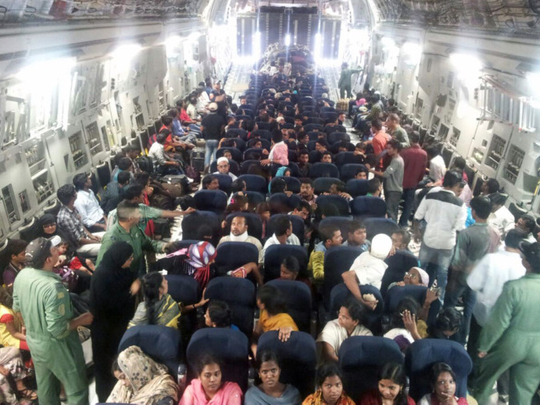
Dubai
On March 31, when INS Sumitra, an Indian naval vessel, was suddenly redirected from its customary patrol of the high seas in the Gulf of Aden and told to anchor at Aden harbour instead, little did the sailors realise that they were about to make it into the history books as part of one of India’s largest-ever overseas rescue and evacuation missions.
What followed over the next fortnight or so was little short of a celluloid thriller as man and machine worked with clockwork precision to ensure that those stranded in strife-torn Yemen — where the Saudi Arabia-led coalition forces launched Storm of Resolve against the Al Houthi militia — would have a safe passage to their respective countries of origin. The fact that this operation involved close coordination between so many different entities — Ministry of External Affairs (MEA), Indian Air Force, Air India, Saudi Arabian government and several foreign embassies — and given the fact that apart from India, there were citizens of different nationalities who were also evacuated, made the scale of ‘Operation Rahat’ massive.
Two Indian Air Force C-17 Globemaster aircraft, three Indian Navy vessels, two passenger ships, a Boeing 777 and three Airbus A320/321s belonging to Air India, close to 50 crew and servicemen, one Union minister and loads of courage and conviction saw India pull off one of the largest offshore evacuation missions in its history — successfully extricating a total of 6,688 people from Yemen, of which 1,947 were non-Indians, as part of what was aptly called ‘Operation Rahat’ – ‘Rahat’ meaning ‘release’ in Hindi.
Joint effort
Speaking in the parliament, India’s Foreign Minister, Sushma Swaraj, said: “It was a joint effort of several Indian ministries and agencies, supervised and coordinated by the Ministry of External Affairs (MEA). We successfully evacuated Indians from Yemen under very difficult circumstances. As the Indian embassy was among the handful of foreign missions operational in Sana’a after the air strikes began, we received formal requests from 33 countries for assistance in evacuation of their nationals. We responded positively to these requests to the extent possible based on ground realities and [ultimately] helped evacuate nationals of 48 countries.”
A makeshift command centre was established at Djibouti Palace Kempinski Hotel to coordinate between the various agencies that were involved in the evacuation mission.
“There was a control room set up by the MEA at our hotel in Djibouti and from there we used to have cross-coordination between the MEA, Indian Air Force, Air India and the various embassies whose citizens were among those rescued,” a co-pilot who was part of Operation Rahat told Gulf News from New Delhi.
Two C-17 Globemaster aircraft belonging to Indian Air Force were pressed into service. However, flying into a war zone had its obvious sensitivities and that is why these heavy-duty Air Force transport planes were not allowed to enter the airspace of Sana’a. Instead, they were parked at Djibouti airport. Similarly, a wide-bodied Air India Boeing 777 was flown in from Mumbai to Djibouti. Since the runway at Sana’a was badly damaged due to the war, a Boeing 777 could not land there.
“So the plan was to fly in a Boeing 777 from India, along with a spare set of crew, and three single-aisle Airbus A320/321s. The narrow-bodied Airbus planes would fly from Djibouti to Sana’a and fly back to Djibouti again with the evacuated passengers. Once in Djibouti, these passengers would be offloaded from the Airbus A320/321s and put on the Boeing 777 and the Globemasters for the journey back to India. Plus, the INS vessels used to bring in stranded people from Aden and all over Yemen to Djibouti, where they were put on the Boeing 777 and the Globemasters for the final leg of the journey back to India,” the co-pilot said.
“This routine was followed somewhat in keeping with a demand-supply mechanism. We would run as many sorties as were deemed necessary on a given day,” he added.
And running sorties in a war zone was always going to be risky and challenging. The Saudi authorities had allowed about three to four hours of a window each day for Indian civilian aircraft to fly into Sana’a and evacuate stranded residents. “On some days, it was suddenly announced that the window would not be allowed because of heavy fighting Sana’a. It would have been extremely risky for any civilian aircraft to use the airspace of Sana’a. And so a trip would be aborted at the very last minute over safety concerns, while on other days even two trips were possible,” the co-pilot added.
These decisions were taken on the basis of a day-to-day evaluation of the ground reality. In fact, Air India happened to be the only civilian airline operating evacuation flights out of Djibouti during Operation Storm of Resolve.
And having a Union minister on the spot really helped ensure a glitch-free delivery module. V.K. Singh’s presence right at ground-zero was one of the most redeeming features of the entire operation. “Honestly, we never felt that we had a minister present with us at ground-zero. I mean, he never gave us the feeling that a VIP was around. He used to queue-up with us at the hotel buffet and used to share the table with us. And yet, he was the man who was leading the entire operation in Yemen. He was always there with us at the briefings and followed the entire operation by the inch. His presence certainly helped boost the morale of all those who were working under him,” the cockpit crew member added.
It is interesting to note that while neighbours India and Pakistan have often been busy trading gunfire across the border, during the recent war in Yemen, both countries helped rescue and evacuate each other’s citizens on several occasions, thereby adding credence to the adage that a crisis often brings the best out of us!













